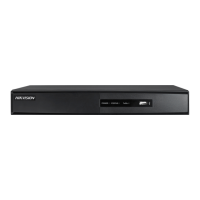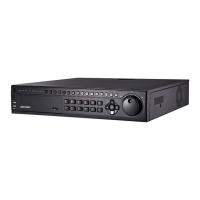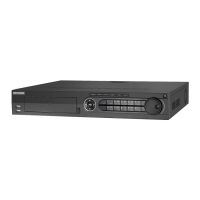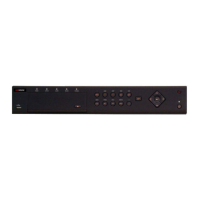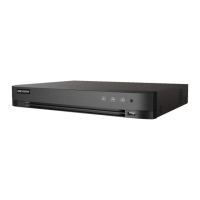
Do you have a question about the HIKVISION DS-7200-ST Series and is the answer not in the manual?
| Video Input | 4/8/16 channels |
|---|---|
| Video Output | 1 channel HDMI, 1 channel VGA |
| Compression Format | H.264 |
| Network Interface | 1 RJ-45 10/100 Mbps self-adaptive Ethernet interface |
| Audio Output | 1 channel |
| USB Interface | 2 USB 2.0 |
| Operating Temperature | -10°C to +55°C (14°F to 131°F) |
| Audio Compression | G.711u |
Provides a comprehensive overview of the DS-7200-ST Series DVR's capabilities.
Details key features like H.264 compression, local monitoring, and hard disk management.
Illustrates typical network setups and connections for the DVR.
Explains various methods for navigating and operating the DVR.
Covers the correct procedures for powering the DVR on and off to ensure longevity.
Describes how to restart the DVR or lock it for security.
Guides users through initial important settings via an interactive setup wizard.
Essential step to accurately timestamp recordings and events by setting system time.
Explains the icons and information presented on the Live View screen.
Details how to operate the DVR in Live View mode using different methods.
Describes quick access functions via the mouse right-click menu.
Guides on setting up video output modes, display modes, and camera order.
Allows users to customize the sequence of cameras displayed in live view.
Explains channel-zero encoding for reduced bandwidth in remote viewing.
Covers setting up recording schedules, motion detection, and sensor alarms.
Steps to configure basic recording parameters like resolution and frame rate.
Enables users to set up flexible daily or weekly recording schedules.
Instructions on initiating a manual recording session for selected cameras.
Methods to prevent file deletion via locking or setting HDD to read-only.
How to lock or unlock individual recorded video files.
Configures an HDD to prevent overwrites, safeguarding important recordings.
Advanced HDD configurations, including setting up redundancy.
Configures dual HDD setup for data protection against drive failure.
Allows users to play back recorded video files from specified periods.
How to play back recordings for individual cameras.
Search and play back recorded files using specific search parameters.
Playback of recordings triggered by specific events like motion detection.
Accessing playback directly from the Live View interface.
Playback of video associated with system log entries.
Allows frame-by-frame playback for detailed analysis.
Instructions on backing up recorded video files to external devices.
Exporting video search results to a USB device or DVD writer.
Exporting recorded files found via event search criteria.
How to select and export specific video clips during playback.
Operations for managing devices used for backup, like creating folders and formatting.
General guide for setting up various alarm triggers and actions.
Configure motion detection areas, sensitivity, and trigger actions.
Set up recordings triggered by external relay alarm devices.
Manually trigger alarm outputs through the Manual Alarm menu.
Enables detection of video signal loss and triggers defined actions.
Detects and alerts on unauthorized video tampering.
Configure alerts for system events like HDD full or network disconnection.
Essential for remote monitoring and management over a network.
Setup of IP address, subnet mask, and gateway for network connectivity.
Guides on setting up Point-to-Point Protocol over Ethernet for network access.
Configures Dynamic DNS services for remote access using domain names.
Synchronizes DVR's clock with an NTP server for accurate timekeeping.
Sets up the DVR to send alarm signals to a remote host.
Optimizes video streaming over networks using multicast addresses.
Allows modification of default server and HTTP ports for network access.
Sets up email notifications for alarms and events.
How to access and navigate through the PTZ control menus.
Essential configuration for PTZ cameras, including baud rate and protocol.
Programming PTZ camera movements, including presets, patrols, and patterns.
Explains the functions of the PTZ control interface buttons.
Steps to set and call specific PTZ camera positions (presets).
Programming PTZ cameras to move between presets automatically.
Recording and playing back PTZ camera movements as patterns.
Configures On-Screen Display settings like camera name and date/time.
Sets video output modes (VGA, CVBS) and input modes.
Adjusts image parameters like brightness, contrast, and saturation.
Masks sensitive areas in the camera's field of view.
Overview of HDD management functions.
Crucial step to prepare a new HDD for use by formatting it.
Organizes multiple HDDs into groups for specific recording tasks.
Changes HDD status to read-only or read/write (R/W).
Protects important recorded files from being overwritten.
Monitors the operational status of installed HDDs.
Sets up alarms for HDD errors or uninitialized states.
General system configurations like language, resolution, and time zone.
Basic system setup including language, time zone, and display options.
More advanced system settings like device name and operation timeout.
Configures serial port settings for connecting external devices.
Manages user access levels and permissions for the DVR.
Creates new user accounts with specific privileges.
Removes existing user accounts from the DVR.
Edits user information and permissions.
Saves and loads DVR configuration settings for easy deployment.
Sets up Daylight Saving Time parameters for accurate timekeeping.
Instructions for updating the DVR's firmware via USB or FTP.
Resets the DVR to its original factory default configurations.
Displays detailed information about the DVR's hardware and software.
Accesses and searches system logs for events and errors.
Definitions of technical terms and acronyms used in the manual.
Frequently asked questions and their solutions for common issues.
